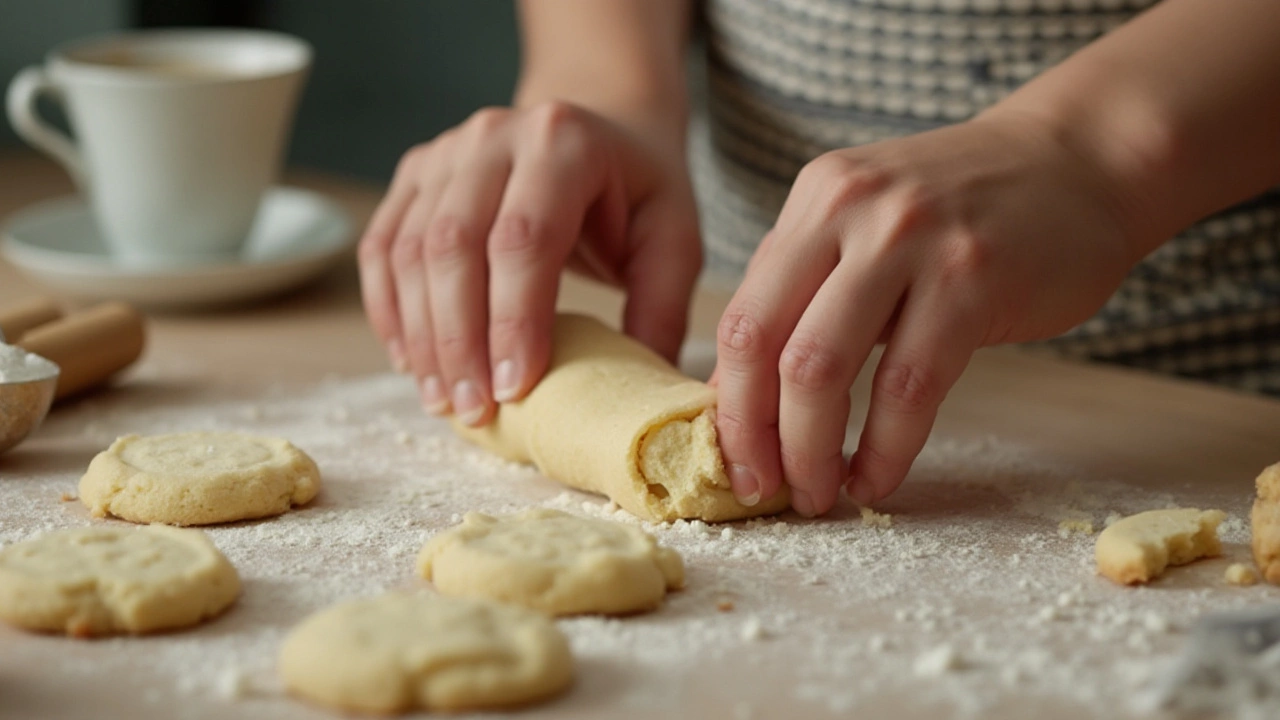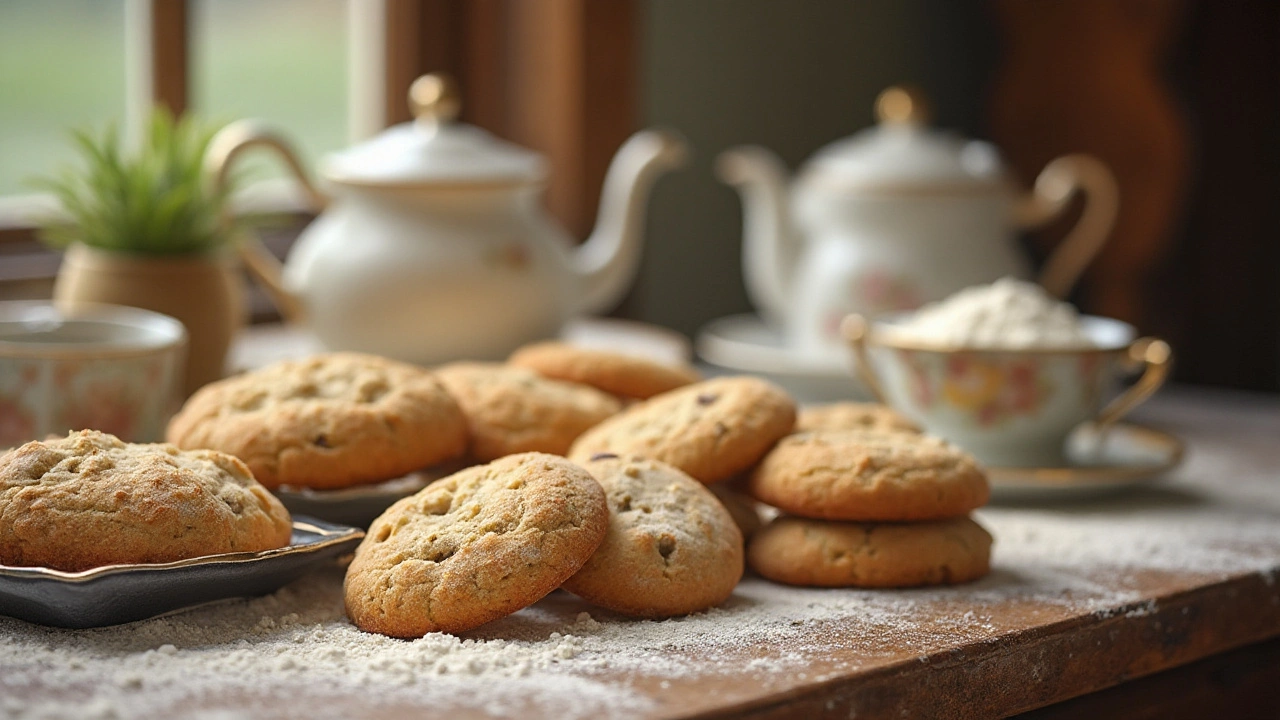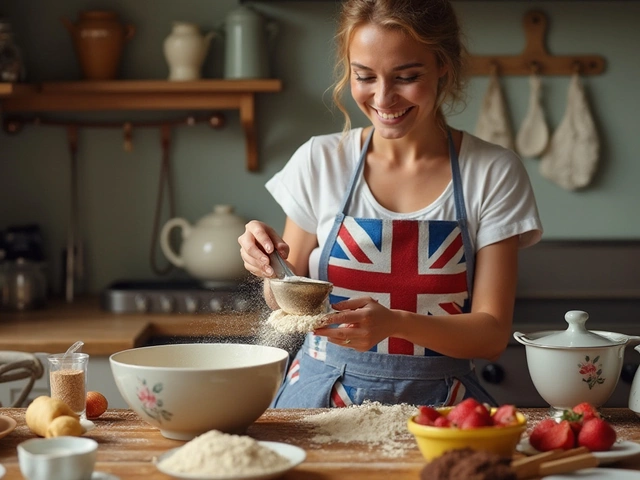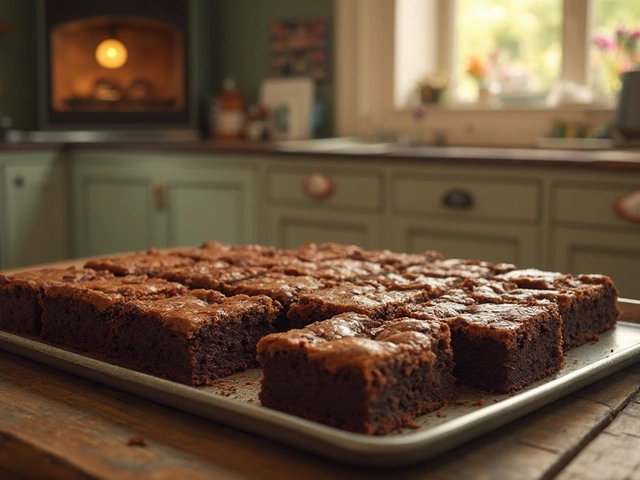When you think of cookies, luscious images of gooey chocolate chips and spicy gingersnaps often come to mind. But, what if you’re out of self-raising flour and only plain flour sits on your pantry shelf? Can you still whip up a mouthwatering batch of cookies? The answer, much to many a baker’s relief, is yes.
Plain flour, a staple in the world of baking, holds the key to creating a fabulous dough that serves as the backbone of your cookie creations. It doesn’t come with added rising agents like self-raising flour, granting you the flexibility to control exactly how much leavening your cookies need. Understanding how to use plain flour effectively can open a world of baking possibilities, enabling you to craft cookies that are every bit as delightful and comforting as those prepared with more specialized flours.
Delve into the art of using plain flour in cookies, adapting recipes as needed, and adding personal flair with an array of flavors. Whether you’re a novice baker or a seasoned pro, experimenting with plain flour could just be the challenge your cookie game needs.
- Understanding Plain Flour
- The Science Behind Cookies
- Making Adjustments for Texture
- Substituting Ingredients
- Exploring Recipes
- Baking Tips and Tricks
Understanding Plain Flour
At the core of many baking endeavors lies plain flour, also known as all-purpose flour. This versatile ingredient is created by milling both hard and soft wheat, leading to a balanced protein content usually around 10 to 12%. Plain flour's distinctive feature is its absence of any added leavening agents, unlike its well-known counterpart, self-rising flour. This characteristic allows bakers to have more control over the texture and rise of their baked goods, making it a preferred choice for recipes where precision is key. Its neutral taste and fine texture make it invaluable not just for cookies, but for a myriad of other delicious creations like cakes, pies, and bread, creating a delightful crumb and structure.
One intriguing aspect of plain flour is its adaptability, and understanding how it interacts with other ingredients can elevate your baking game. Typically, the proteins in plain flour are what form gluten when mixed with water. Gluten gives structure and elasticity, which is essential in baking, especially for achieving that perfect cookie bite. However, too much gluten can make cookies tough rather than tender. It’s all about balance, as any seasoned baker knows.
In terms of scientific relevance, plain flour has just about the right amount of protein content needed to add necessary strength without compromising lightness. According to a study from the Journal of Food Science, manipulating the protein content in flour impacts crumb firmness and moisture retention, which are critical components in cookie texture. The precise composition of plain flour provides an excellent canvas for bakers to experiment with textures and flavors.
"Flour is the cornerstone of baking, its various types tailor-made for different outcomes," says Emily Luchetti, a celebrated pastry chef.
When you use plain flour, you engage in a bit of culinary science. By adding baking powder or baking soda, you incorporate the needed lift that plain flour alone cannot provide. These leavening agents work by releasing carbon dioxide, which causes the dough to increase in volume. When preparing cookies, measuring these ingredients accurately is crucial to achieving the desired result. Keep in mind that the consistency and moisture content of your dough can also significantly influence the outcome, and plain flour plays a vital role in locking in these attributes.
For those enthusiastic about exploring their own cookie recipes, consider that the use of plain flour necessitates a keen awareness of ingredient ratios. Balancing sugar content and fat, often butter, against the flour can entirely transform the outcome, leading to either soft, chewy bites or delicate, crispy textures. This is why plain flour is favored by not just professional bakers but also those dabbling at home—it invites experimentation and rewards understanding with delicious results.
Interestingly, statistics from the U.S. Department of Agriculture reveal that around 60 million tons of plain flour are produced globally each year, indicating its unquestionable popularity and utility in the kitchen. When diving into the world of homemade cookies, leveraging the properties of plain flour provides the opportunity to explore a multitude of flavors and cookie styles, each with their unique charm and deliciousness. This makes it an asset worth understanding, especially for those passionate about mastering the art and science of baking.
The Science Behind Cookies
When you sink your teeth into a perfectly baked cookie, the delightful blend of texture and flavor doesn’t happen by accident. It’s a charming dance of chemistry and cooking magic. At its heart, a cookie is the product of various chemical reactions, where each ingredient plays an essential role. Understanding these roles can help you achieve the perfect cookie every time you reach for plain flour from your pantry. Plain flour primarily consists of proteins and starch. When mixed with wet ingredients and baked, proteins form gluten, which provides structure and chewy texture. Meanwhile, sugars melt in the heat, creating that enticing golden-brown hue thanks to the Maillard reaction, a process that also deepens the flavor profile of cookies.
In the absence of chemical leavening agents like baking powder, plain flour requires strategic recipe adjustment to yield the desired fluffiness. Adding a precise amount of baking soda can make a tremendous difference, encouraging the dough to rise by producing carbon dioxide during baking. This not only affects the thickness but also the tenderness of the cookie. Fat, typically butter, is another unsung hero, acting as a tenderizer and flavor enhancer. It disrupts the gluten network, keeping cookies from becoming too tough while contributing richly to taste. The temperature of your butter can alter your cookie outcome too; cold butter often results in a denser cookie, while softened butter aids in spreading and a more uniform texture.
Eggs bring more than just moisture to the equation. They provide additional proteins, emulsify the mixture, and contribute to the structure and soft texture. Their lecithin content aids in binding water and fat, ensuring a consistent dough and an even bake. The choice of white sugar or brown can dramatically change your cookie's character. White sugar results in crispier textures, while brown sugar, with its molasses content, yields a chewier bite and deep caramel tones.
“Baking is both an art and a science, balancing precise measurements with creative intuition,” says pastry chef Lynn Kearns, emphasizing the transformative process that turns simple ingredients into culinary joy.
Seasoned bakers often experiment with these basic elements, tweaking ratios and techniques to create personalized cookie profiles. For instance, altering chilling times can impact how the butter solidifies, influencing spread and texture. Knowing the science behind each ingredient empowers home bakers to take control of their cookie-baking destiny and not to shy away from using plain flour as a foundation for their sweet creations. It’s all about embracing the flexibility and letting curiosity guide your hand as you craft your perfect cookie batch.

Making Adjustments for Texture
Achieving the perfect cookie texture is a fine art that involves a deep understanding of your ingredients, especially when using plain flour. Unlike self-raising or specialized flours, plain flour lacks any leavening agents, which means you’ll need to add your own magic to ensure your cookies are exactly how you like them - whether that's soft and chewy or crisp and crunchy. Adding baking powder or baking soda can give your cookie dough the lift it needs. Generally, a teaspoon of baking powder per cup of plain flour can yield a balanced rise, but experimenting with the mixture can lead you to your personal sweet spot.
Baking is both a science and an art. The interplay of plain flour, fats, sugars, and leavening agents determines the final outcome of your cookies. If you're aiming for a chewy texture, the water content in butter plays a crucial role. Melting your butter before mixing can help achieve that desired chewiness as it encourages gluten formation. To enhance the chewiness, you might consider using brown sugar, which brings moisture and a deeper flavor profile compared to granulated sugar. Controlling the ratios of these ingredients allows not just flexibility but also an exciting creative journey in baking.
On the other hand, if you prefer your cookies to have a distinct crunch, you might opt to chill the dough before baking. This reduces spreading in the oven and leads to a thicker, more structured cookie. Increasing the baking soda slightly can also aid in creating a crisp exterior while ensuring the inside remains soft. More so, adding a bit of fine cornmeal or even swapping part of the flour for almond flour can add a delightful texture, giving your cookies a unique bite and enhancing flavor.
Renowned pastry chef Dominique Ansel once remarked,
"The secret to great pastry is precise balance in ingredients. It’s all about understanding what each component brings."This wisdom holds true especially when you’re baking with plain flour. Finding that balance allows you to create cookies that could rival even the fanciest patisseries. Remember, practice makes perfect, and each batch is a learning experience. Enjoy the process, and let each cookie tell its own delicious story.
Substituting Ingredients
When crafting homemade cookies, the beauty of the kitchen is in its adaptability. If your pantry lacks a specific ingredient, like self-raising flour, switching up components can be a delightful experiment. The concept of substitution partly relies on understanding the properties of plain flour and how it interacts with other ingredients to maintain the texture and taste of your cookies. By adding leavening agents such as baking powder or baking soda, you can compensate for the absence of naturally rising properties in plain flour. Often, the rule of thumb is to add about a teaspoon of baking powder per cup of plain flour. Nevertheless, this is not a one-size-fits-all scenario, so tweaking and testing your method might lead to your next signature batch.
On the other hand, you might find yourself short on something like butter, a classic cookie staple known for its richness. Substitutes like margarine or even certain oils can step in, though they will alter the cookie's texture slightly. Margarine provides a similar consistency but typically contains more water, potentially making the dough spread more. Swapping butter with oil—olive or coconut, for instance—will not only alter the moisture content but also subtly infuse the dough with these oils' unique flavors. Don’t shy away from such changes; each attempt brings about learning in the world of baking.
Speaking of flavor, a sugar substitute is another common theme in today’s kitchens, especially with the rise of health consciousness. Honey, maple syrup, or agave can replace granulated sugar in a one-to-one ratio; yet, remember that these substitutes add additional liquid to the dough. You should slightly reduce other liquid components, like milk or water, to maintain the desired dough consistency. Unexpected ingredients can also serve as helpful binders. For instance, unsweetened applesauce or mashed bananas add both moisture and natural sweetness when you aim to cut down on sugar content.
"Baking is all about precision. Still, few things are as rewarding as achieving your desired taste and texture with a few imaginative swaps," shares Joy Wilson, author of 'Joy the Baker Cookbook'.
For those allergic to wheat or catering to dietary restrictions, substituting plain flour altogether may be necessary. Here, alternatives such as almond flour or gluten-free blends come into play. These flours have different flavor profiles and densities, typically requiring a conversion to about 1 and 1/4 cups of almond or gluten-free flour for each cup of plain flour. Their distinctive features mean recipes and proportions must be deliberate to ensure the successful binding and rising of your cookies.
Substitution is akin to a culinary dance—a balancing act that blends science and creativity. When substituting ingredients, keeping measurements precise is fundamental, but don’t forget to include a sprinkle of adventure and delight in each attempt. After all, the heart of home baking lies in personal touch and experimentation, creating delightful and memorable flavors that are uniquely yours. While the substitutions may seem daunting initially, embracing them with open curiosity might lead to unexpected discoveries. Remember that some substitutions will require a small period of adjustment, so be patient and enjoy the process—your perfect cookie awaits.

Exploring Recipes
Diving into the world of cookie recipes when working with plain flour can be an exciting journey. Unlike self-raising flour, which includes a leavening agent, plain flour requires you to be a bit more hands-on and mindful of your ingredient choices. This lack of automatic lift might deter some, but it unlocks the potential to fine-tune textures and flavors in ways that suit your personal preference and creativity. The adaptability of plain flour means it can be used in a wide variety of cookie recipes, from crunchy chocolate chip classics to fudgy brownies, by simply altering accompanying ingredients like baking powder or baking soda.
To create the perfect chocolate chip cookie with plain flour, a reliable starting point is to incorporate about a teaspoon of baking soda alongside the flour. Begin by creaming butter and sugar until light and fluffy, enhancing the flavor. Adding vanilla extract provides that quintessential cookie aroma and taste. The use of plain flour in this mix ensures a balanced texture — chewy yet firm, created by carefully measured baking soda that acts as the leavening agent. This balance is crucial and highlights the importance of precision when baking with plain flour.
Moreover, exploring recipes with plain flour allows experimentation with international cookie favorites. Take the beloved Polish pierniczki, a gingerbread-like cookie that uses a mix of spices in conjunction with plain flour. The dough, once prepared, can be enhanced with ingredients like honey or molasses for richness, while the addition of a generous scoop of spices provides depth. Not only do these additions complement the use of plain flour, but they also increase the stability and robustness of the final product, ensuring that each cookie carries a deep flavor balance that resonates with authenticity.
Here’s an interesting fact: Guinness World Records officially recognizes the largest cookie ever baked as measuring in excess of 102 feet across and weighing around 40,000 pounds! A feat like this, while not exactly practical, certainly inspires home bakers to think big, showing that sometimes cookie creations made with humble plain flour can reach monumental heights. In everyday terms, dive into altering a traditional snickerdoodle recipe by swapping out self-raising flour with plain flour, and adding a pinch of cream of tartar for an extra chewy texture.
Embracing versatility with plain flour also means stepping into the area of healthier cookies. One can easily adjust recipes to include whole grains, oats, or alternative sweeteners, adjusting the wet-to-dry ingredient ratio to maintain a desirable cookie dough consistency. For example, oatmeal raisin cookies can be made more heart-healthy by incorporating whole oats and cutting down on sugars, letting the naturally sweet raisins shine through. Using plain flour as a base, in this case, accentuates the wholesome essence of the treat.
“Baking cookies is like suffusing love into bite-sized treats. Allow every ingredient, no matter how simple, to shine in its own right.” — Mary Berry, respected baking authority.Establishing a range of recipes with plain flour invites a comprehensive and often educational experience in the kitchen. It invokes creativity, precision, and a touch of experimentation, giving you the freedom to craft cookies that are not only unique to your kitchen but also representative of traditional, tried-and-tested methods from chefs around the world. Remember, the key to success lies in understanding the role each ingredient plays in harmony with the others.
Baking Tips and Tricks
Baking with plain flour offers both challenges and opportunities. Many bakers find that understanding the nuances of this versatile ingredient can result in cookies that defy expectations. To ensure your dough transforms into the perfect batch of cookies every time, start by paying close attention to the texture of your dough. Too sticky, and adding a tablespoon of additional flour at a time can help; too dry, and a splash of milk or water might do the trick. With plain flour not containing any raising agents, precision is key, particularly in the measurements of supplementary ingredients like baking soda and baking powder. This fine-tuning will help develop cookies that rise just the way you want.
Temperature plays a significant role in determining how your cookies turn out. For perfect results, all ingredients should be room temperature. Cold eggs can cause butter to clump, and room temperature ingredients blend more smoothly, helping incorporate air into the dough. It’s also crucial to chill the dough for at least 15 minutes before baking; this helps prevent the cookies from spreading too much and enhances flavor. Make sure to preheat your oven to the correct temperature. An oven thermometer can be invaluable since many ovens don't always hold the precise temperature they claim.
Some bakers turn to plain flour because of its unique ability to let flavors shine without overpowering subtleties. Experiment with daring combinations like sea salt and dark chocolate or add a touch of spice with cinnamon or cayenne pepper to bring out the sweetness in your cookies. Don’t be afraid to sprinkle in a variety of textures; chopped nuts, seeds, or dried fruits add exciting contrasts that can elevate the humble cookie. Remember, baking is as much a science as it is an art. Keeping a journal of each baking session, noting oven temperatures, times, and ingredient ratios, can help replicate those perfect results or adjust for personal taste preferences.
Bake only the first cookie sheet to start. Tweak the remaining dough if needed, based on the results. This tip from acclaimed pastry chef Dorie Greenspan optimizes your efforts, capturing your ideal cookie on the rest of the batch.
It’s always worthwhile to have a basic grasp of the variations in flour types, primarily how plain flour compares with self-raising varieties in recipes. To create a balanced cookie, understand that the amount of gluten development affects the cookie’s texture. The longer you mix, the more the gluten develops, resulting in a chewier cookie. If you prefer a softer, cake-like finish, stir just until the ingredients combine to reduce gluten formation. Rotating your cookie sheets midway through baking ensures even cooking – hot spots in ovens can otherwise lead to unevenly baked cookies that are burnt on one side and undercooked on the other. Use a spatula to get the last bit of dough from the bowl; it ensures no ingredients are wasted and maintains a consistency batch-to-batch.
Try experimenting with different sugars such as brown or coconut to see how they affect both color and flavor. Brown sugars contribute a lovely caramel undertone and extra moisture, while white sugars provide crispiness. Lastly, don’t forget to let your cookies cool on the baking sheet for a few minutes before transferring to a wire rack. They're still cooking from residual heat and this can influence the final texture. Enjoy the art of baking as you uncover diverse ways plain flour contributes to cookie making, opening doors to endless culinary possibilities.





